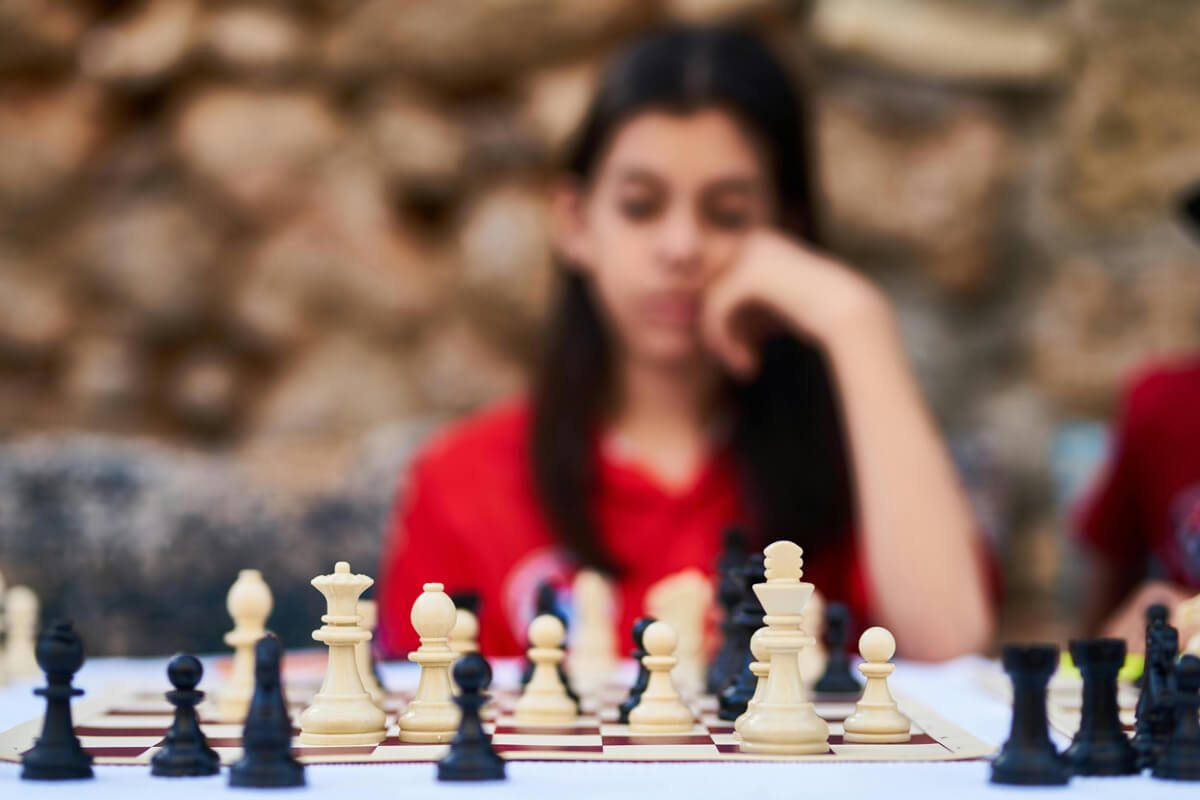

Chess Fundamentals
After school program
About program
Below is an outline for a 3‐month curriculum (24 lessons total) designed for 8–10 year olds. The course is divided into (3) units that gradually build chess fundamentals, introduce tactical and strategic thinking, and then explicitly connect chess lessons to real world critical thinking and decision making skills.
Each lesson will be for a duration of 45 minutes. There will be 2 lesson sessions per week for a total of 24 lessons within a 3-month period. Class size is limited to 10 students maximum.

Chess Fundamentals & Basic Critical Thinking (Lessons 1–8)
Lesson 1: Welcome to Chess & Critical Thinking
• Discuss what “critical thinking” means and how chess can help build this skill.
Lesson 2: The Chessboard & Piece Overview
• Explore the chessboard layout (ranks, files, diagonals).
Lesson 3: Pawn Fundamentals & Incremental Progress
• Learn pawn movement, capturing, and promotion.
Lesson 4: Knights & Bishops: Unique Moves & Lateral Thinking
• Introduce the idea of non linear problem solving (thinking “outside the box”).
Lesson 5: Rooks, Queens, and Kings: Roles and Responsibilities
• Discuss how each piece has a unique “job”—similar to roles in a team or community.
Lesson 6: Special Moves: Castling, En Passant, & Promotion
• Relate these “special moves” to unexpected opportunities in life.
Lesson 7: Game Basics: Rules, Etiquette, and Starting a Game
• Emphasize sportsmanship, turn taking, and respectful competition.
Lesson 8: Introduction to Tactical Thinking
• Begin to connect “if then” scenarios in chess with planning for real-life outcomes.
Chess Tactics, Strategies, & Deep Critical Thinking (Lessons 9–16)
Lesson 9: Opening Principles & Early Game Strategy
• Introduce the idea of planning ahead in both chess and life.
Lesson 10: Tactical Tools: Forks, Pins, and Skewers
• Encourage students to “see” multiple moves ahead—a key aspect of critical thinking.
Lesson 11: Midgame Strategy: Balancing Attack and Defense
• Group discussion: How do we decide what risks to take in everyday life?
Lesson 12: Endgame Essentials & Checkmate Patterns
• Highlight the importance of foresight: every move counts toward the final outcome.
Lesson 13: Pattern Recognition & Problem Solving
• Relate pattern recognition in chess to spotting trends and making decisions in real life.
Lesson 14: Analyzing Moves & Learning from Mistakes
• Teach that mistakes are opportunities to learn and improve, both in chess and in life.
Lesson 15: Time Management & Decision Making Under Pressure
• Link this with making decisions when time is short in real life (e.g., during tests or emergencies).
Lesson 16: Practice Session: Mini Games and Tactical Drills
• Encourage them to verbalize their thought process, linking it to everyday planning.
Applying Chess Skills to Real World Critical Thinking (Lessons 17–24)
Lesson 17: Planning Ahead: Chess as a Blueprint for Life
• Discuss goal setting and anticipating outcomes.
Lesson 18: Creative Problem Solving & Strategy Development
• Emphasize creative thinking and adapting strategies when situations change.
• Group brainstorming and strategy design.
Lesson 19: Teamwork in Chess: Collaborative Challenges
• Highlight how working together can lead to better decisions and shared success.
Lesson 20: Resilience and Adaptability: Learning from Losses
• Discuss the emotional side of chess—how losses can teach us resilience.
• Connect these lessons to handling setbacks in school or personal projects.
Lesson 21: Ethical Choices in Chess and Life
• Explore the importance of fair play, honesty, and sportsmanship on and off the board.
• Discuss ethical dilemmas (in simplified form) and decision making.
Lesson 22: Advanced Strategic Planning: Setting Long Term Goals
• Relate this to planning long term projects or goals (e.g., saving money, preparing for a school event).
Lesson 23: Preparation for the Culminating Tournament
• Review key lessons, tactics, and strategic principles.
Lesson 24: Culminating Activity: Chess Tournament & Life Lessons Reflection
• Host a friendly chess tournament where students apply all they have learned.
• Conclude with a reflective session discussing what chess has taught them about planning, critical thinking, and handling challenges in life.
This outline offers a comprehensive journey from the basics of chess to the integration of its strategic and critical‑thinking lessons into real‑world applications.
